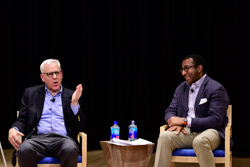Reflections On The 13th Amendment
In a time rife with racial tensions and divisiveness in the US, discussions of the 13th Amendment can often take on new meaning as we struggle to grapple with the past’s connection to the present. At the 2016 Resnick Aspen Action Forum, David Rubenstein — co-founder and co-CEO of the Carlyle Group and ardent preservationist of American history — and Eric Motley — a descendant of one of the first independent African-American towns in the South, Henry Crown Fellow, and vice president of the Aspen Institute — spent an hour unpacking the significance of the abolishment of slavery then and now. Rubenstein also brought original signed copies of the Amendment, along with a copy of the Emancipation Proclamation, for attendees to view.
Rubenstein started the discussion with an in-depth explanation of the history of slavery in the US, from the first indentured servants brought over on ships from Africa to the US, to the first slave, John Punch, a servant who broke the law and whose punishment — slavery — marked the start of generations of slaves in this country.
The discussion took place in front of an audience of Aspen Global Leadership Network Fellows from all over the world. The annual gathering brings together leaders from across sectors to discuss global issues and develop action plans to address them. The four-day event features seminars and workshops geared toward change-agents looking to collaborate and create action pledges to implement in their respective communities.
“Today we still have the racial problems that I think were spawned by slavery and they’re not going to disappear overnight,” said Rubenstein, “we’re still dealing with the residue of those problems for sure. We still have a long way to go before we get to the kind of society that all of us want to have.”
While Rubenstein acknowledged slavery’s role in today’s issues of race in America, he cited another issue closely tied to it.
“The problem is social mobility,” he explained. “Because people at the bottom don’t believe what I believe, that you can rise to the top, you can change your economic structure and well-being if you work hard and do other things. Now I think people at the bottom don’t think they can get to the top, and so the ability of people to get to the top or to the middle even is reduced and I think the social mobility problem is as great as the economic mobility problem.
So what can be done to fully address the intertwined issues of race and mobility? Asked by Motley what advice he would give to the youth leaders in the room, Rubenstein admitted that “no one person” will solve these issues. “…Try to find something that you can do that makes at least your part of the world better, and maybe ultimately it will lead to something better for the whole world.”
Other Recent Posts
The final day of the 2019 Resnick Aspen Action Forum closed with a celebration of intergenerational perspectives that included presentations from young leaders and a discussion between AGLN Moderator and South African Fellow Heather Sonn and Keith Berwick, long-time friend and founding executive director of the Henry Crown Fellowship. ...
When Anousheh Ansari was seven years old, she drew a photo of a rocket flying through space and set her eyes on exploring outer space being astronaut. There was no space program in Iran at the time and the chances of Ansari becoming an astronaut were slim. “I like to prove people wrong,” said Anousheh Ansari on stage at the 2019 Resnick Aspen Action Forum. On ...
The 2019 John P. McNulty Prize laureates, five extraordinary individuals, shared their courageous and bold social impact ventures at the Resnick Aspen Action Forum on Wednesday night. McNulty Foundation President Anne Welsh McNulty, who founded the award in honor of her late husband, described the McNulty Prize as a call to action. “You have shown ...
Borders are a part of life –– whether internal, invisible, geo-political or otherwise. Borders can help and they can harm. Borders are powerful and they can also be a form of power. Understanding the borders that are around and within us can lead to greater self-awareness and open the path for making great change in the world. With inspiration from the ...
1. Draw inspiration from other participants Over 1,000 Action Pledges have been made since the inaugural Action Forum in 2013. Watch the video below on some highlighted Action Pledges. 2. Find your sweet spot The most exciting Action Pledges come from what we call your sweet spot, the intersection of your passions, talents, and your community’s ...


Leave a Comment